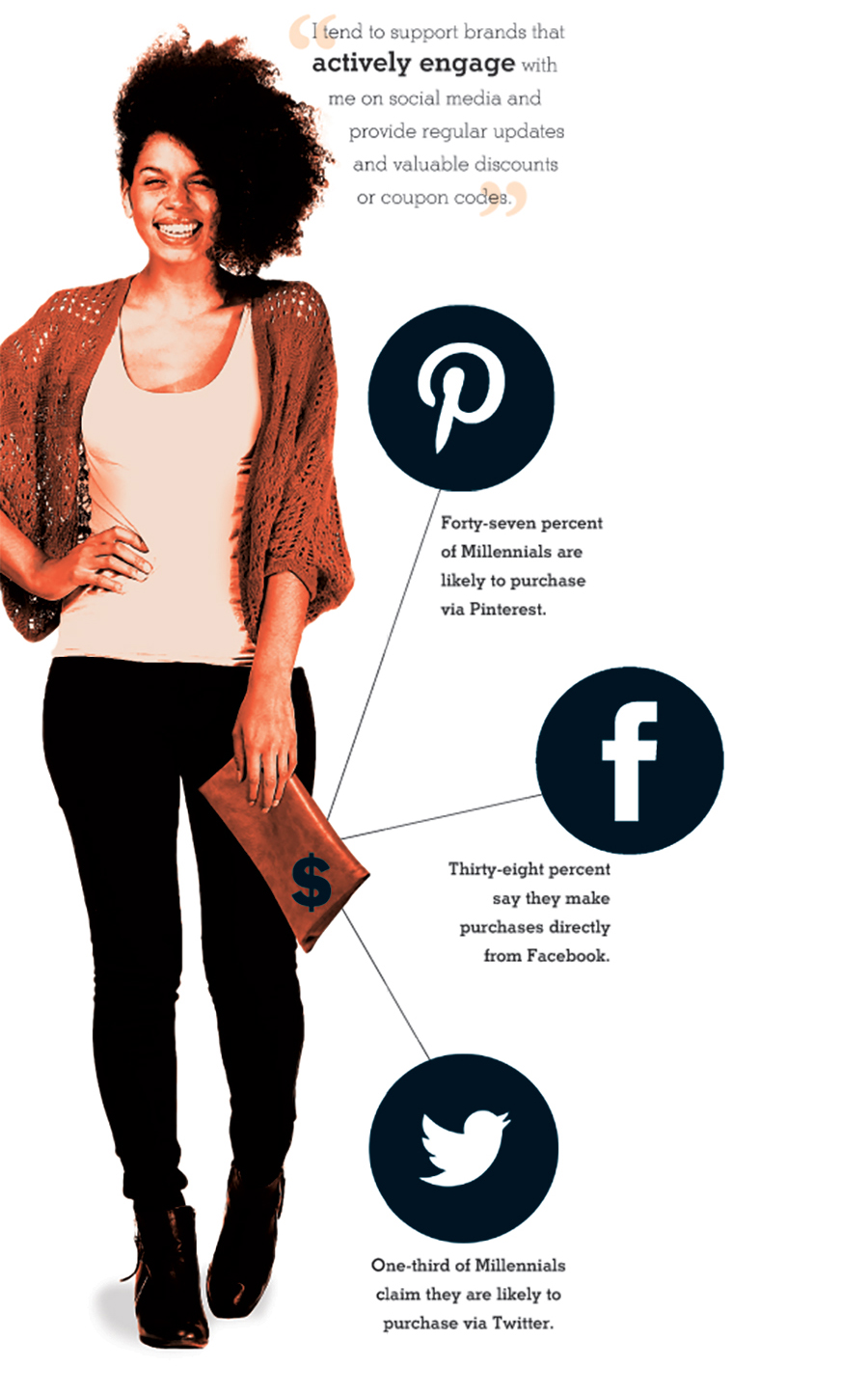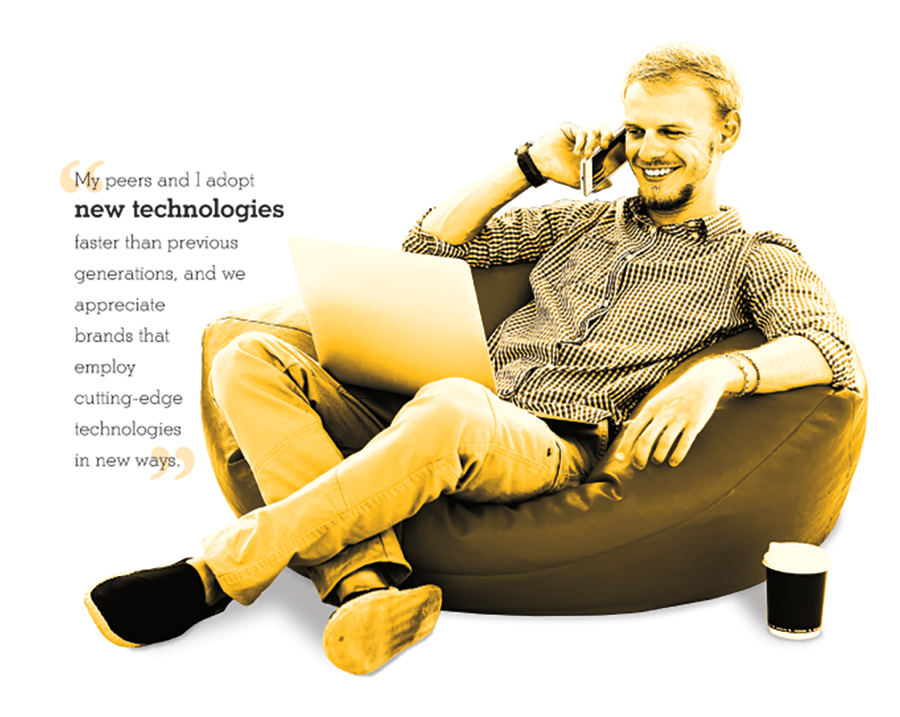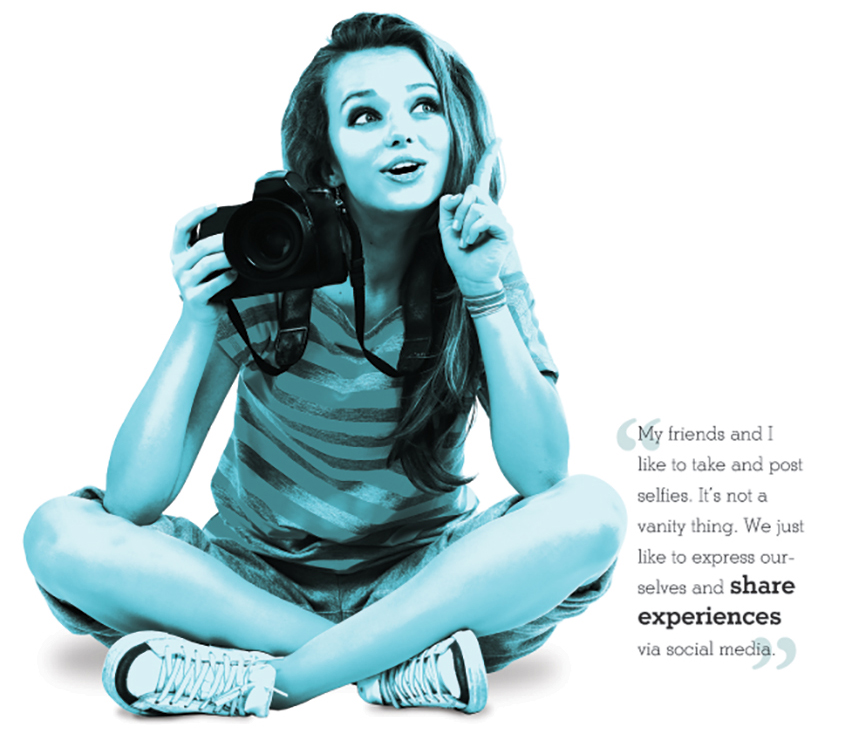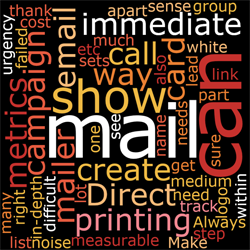|
REGISTRATION REQUIRED
demographics

MILLENNIAL SNAPSHOT
Age: 16 to 34 Size: 83.1 million, about 26 percent of the U.S. population Median income: $25,000 for younger Millennials; $48,000 for older ones Cities with the highest concentration of Millennials per capita: Austin, TX; Denver; Los Angeles; Salt Lake City; and San Diego 13 Things You Should
Know About Millennials Millennials are the Holy Grail for marketers, spending $200 billion annually. But few exhibitors understand this baffling generation, and fewer still know how to approach it. The truth is, there are almost as many myths about Millennials, aka Generation Y, as there are about Greek gods. In reality, this misunderstood generation is tech-savvy, money-shrewd, and socially conscious. And its members are reshaping how we work, play, buy, and even think, usually for the better. To discount or misconstrue them based on often vapid stereotypes is to blithely ignore a demographic tsunami: Millennials currently represent the largest generation in history. And with Generation Y's numerical size comes financial clout. According to data from FutureCast LLC, Millennials make up nearly one-quarter of U.S. adults raking in more than $500,000 annually. Despite the financial wallop they pack, this generation can be as baffling a mystery as the ancient statues on Easter Island. Why should you care? Because, chances are, Millennials are heavily represented among your current customers and prospects, and they may soon comprise the majority of your clients. Thus, the more you know about them, the better you can compete for their business on the trade show floor. So EXHIBITOR scoured dozens of studies on this often-elusive market and found 13 insights to help you reach Generation Y's 83 million members who often seem immune to traditional marketing. By Charles Pappas
1. Sweet Charity
Often billed as the most values-driven generation in history, Millennials gravitate to brands that concentrate on showing how they give back to society. Indeed, 84 percent of Millennials will weigh a brand's perceived values before making a purchase. On top of that, Barkley Holding Company Inc.'s American Millennials study found that Millennials are more likely than members of other generations to buy products from brands that support causes they care about by a margin of 52 percent to 45 percent. To develop brand loyalty with Millennials, then, try promoting any philanthropic efforts your company makes directly alongside your product information. Or consider philanthropic promotions, whereby your company donates a given amount of money to booth visitors' favorite charities. 2. Social Status According to research compiled by the Goldman Sachs Group Inc.'s Millennials: Coming of Age study, 34 percent of Millennials perceive a brand more positively if it uses social media, more than twice the amount – 16 percent – of older cohorts who feel similarly. So to reach Generation Y with your brand's key messages, be sure to establish a robust presence on the social networks that most influence them, from Twitter and Facebook to Pinterest and Instagram. Moreover, while 34 percent of Millennials are impressed if brands use social media, Elite Daily's Millennial Consumer Trends research found a markedly greater number, 62 percent, state that if a brand interacts with them via social media, they are much more likely to become loyal customers. So having a presence is the first step. But exhibitors who make the effort to engage with Millennial customers on social networks are more likely to reap profits and loyalty by communicating through the conduits this generation prefers. 3. View Masters When considering a product for purchase, more than 60 percent of Millennials prefer watching a video about it over reading text. That's one of the many findings of Animoto Inc.'s Online and Social Video Marketing Study. In fact, Generation Y is so partial to video that, when comparison shopping, they're an astounding 150 percent more likely than baby boomers to watch online videos about a product while in a store, and 146 percent more likely than boomers to view a video on a company's website while they're shopping online. Exhibit and event marketers may be able to address this tendency by posting demo videos or recorded customer testimonials on their websites, or by sending links to those videos via email as a post-show touchpoint. The potential payoff for this approach is as stupendous as it is simple: Roughly six out of every 10 Millennials are more likely to comment on, share information about, or like a brand they encounter on social media if it posts videos. Plus, Millennials are 264 percent more likely to share videos about a brand while shopping online than baby boomers. 
4. Brand Followers Social media is not only where Millennials congregate with family and friends but also where they follow companies and brands. The key for exhibitors is to use the sites that spur brand following as well as those that convert followers into buyers. A study from The Center for Marketing Research at the University of Massachusetts Dartmouth found that Facebook, YouTube, Twitter, and Pinterest generated the most brand followers. When it came to buying, Millennials were most likely to make a purchase via Pinterest (47 percent), Facebook (38 percent), and Twitter (33 percent), respectively. Thus, marketers may benefit from focusing their online presence and targeting these particular sites. Furthermore, when asked what prompted them to like, follow, or pin a company or brand on Facebook, Twitter, Pinterest, or Instagram, Millennials most often cited at least one of four reasons: receiving regular updates from brands; getting a coupon or discount; supporting the brand; or researching the brand. Canny exhibitors could exploit this by furnishing a regular flow of news to these sites, offering discounts, and supplying in-depth info that allows followers to do more comprehensive research on the company's offerings. 5. Must Love Blogs Less than 3 percent of Millennials believe they're influenced by old-style conduits for product info and recommendations, such as TV and newspapers. But when searching out product information, one-third of Generation Y often turns to blogs before completing a purchase. That bit of insight into the Millennial mind hails from Elite Daily's Millennial Consumer Trends study. And Millennials don't just surf over to any of the world's estimated 150 million or so blogs randomly. Instead, they look for those possessing authenticity, a quality partly conveyed by an accessible and visible human presence, rather than a generic corporate façade and blatant paid endorsements. As such, exhibitors should make themselves aware of influential bloggers in their sectors and use trade shows and events to court them and foster relationships. Even better, consider creating an in-booth press lounge like Intel Corp. did at the 2016 International Consumer Electronics Show. The second-story space, available to both traditional journalists and tech-industry bloggers, offered complimentary Wi-Fi access, charging stations, comfortable seating, and an assortment of food and beverage options. 6. Image is Everything When marketing to members of Generation Y, exhibitors must employ imagery that will resonate with its unique sensibilities. The Boston Consulting Group Inc.'s How Millennials Are Changing the Face of Marketing Forever research paper suggests that effective visuals often include depictions of the many cultural "tribes" Millennials populate, such as classmates, co-workers, multigenerational families, or even strangers banding together for a common purpose (e.g., a charitable effort or a concert). In particular, visuals should reflect Millennials' varied world, marked by diverse family structures, heightened racial inclusivity, and relaxed gender roles. 7. Event Horizon The love of live events is a defining characteristic of Millennials. Almost eight in 10 say some of their most cherished memories stem from a live event they experienced. That's one of the significant findings of the Nielsen Co.'s Breaking the Myths report on Millennials. What's more, Momentum Worldwide's analysis of Millennial music fans revealed that an overwhelming 93 percent prefer brands that sponsor live events, with 80 percent saying the most effective way to connect with them is through a branded live-music experience. Exhibitors who capitalize on these discoveries by offering in-booth appearances or live events featuring artists that Generation Y customers enjoy should find it a profitable opportunity to leave a lasting impression on loyal Millennial consumers. 
8. Digital Natives One of Millennials' universal attributes is the eagerness with which they embrace technology. In fact, according to the data in American Millennials, a report from Barkley Holding Company Inc., Millennials are 250 percent more likely to be one of the very first to adopt technology compared to more senior generations. Marketers can take advantage of this large disparity by bringing cutting-edge technology to their booths – such as augmented- or virtual-reality devices – as well as by engaging with Millennials via the most current social-media outlets, including Periscope, Snapchat, Yik Yak, and Slack, to promote their wares. 9. Selfie Interest A Pew Research Center poll, Millennials in Adulthood, discovered that 55 percent of Generation Y had posted a selfie online, compared to just 9 percent of baby boomers. In fact, Millennials will snap a projected 25,700 selfies over the course of their lifetimes. That knowledge indicates that photo booths and other in-booth photo ops are likely to resonate with this generation. Even offering colorful backdrops in your exhibit, adding quirky mascots, or just creating picture-perfect vignettes conducive to close ups can result in digital self-portraits that Millennials can post online and send to their friends, thereby extending your brand far beyond the booth. 
10. House of Cards In the shuffle for VIP gifts, in-booth prizes, or promotional giveaways, exhibitors would do well to opt for gift cards instead of other comparably priced items. But a study from Bankrate Inc. says Millennials prefer general-purpose cards over ones for a specific retailer. So rather than distributing gift cards for Starbucks or iTunes, consider handing out Visa or MasterCard gift cards. If you must distribute traditional giveaways, data from Adweek magazine claims Millennials favor reusable bottles over other promotional tchotchkes. 11. User Friendly User-generated content (UGC) – such as reviews on Yelp, TripAdvisor, and Amazon.com – largely steers what Millennials buy, concluded Bazaarvoice Inc.'s Talking to Strangers study. Indeed, a whopping 84 percent of Millennials state that UGC guides what they purchase, markedly more than the 70 percent of boomers who say the same thing. According to the survey, 51 percent of Millennials trust UGC over the official information located on a company website, more than three times the 16 percent of boomers who do. Whenever possible, then, exhibitors should steer Generation Y customers to any such sites that might review or mention their brand. Even featuring authentic user reviews on in-booth graphics and product literature can help mitigate Millennials' distrust of traditional marketing. 12. Private Parts Not only is privacy a negotiable commodity for Millennials, says a study by Bovitz Inc. and the USC Annenberg Center for the Digital Future, but it's also one of this generation's biggest differentiators. About 25 percent would trade some personal information in exchange for advertising they find more applicable to their lives, contrasted with 19 percent of people 35 and older. And a majority – 51 percent – say they are willing to share information with companies as long as they get something in return, compared with just 40 percent of those 35 and older. For exhibitors, that means lead capture and surveys with Millennials can be successful – so long as members of Generation Y are rewarded with something of particular value. Furthermore, 56 percent of Millennials say they're willing to share their physical location with businesses in order to receive some kind of financial incentive, while only 42 percent of older generations would go along with such a bargain. For exhibitors, that means a smart way to win Millennials' cooperation might be to offer discounts, exclusive perks, or premium-quality giveaways, especially when using proximity marketing (aka geofencing). 13. Made in the USA Generation Y wants to buy locally produced – or at least American-made – items, concluded Nielsen Co. in its aforementioned Millennials survey. Despite their well-documented appetite for a deal, Millennials prefer to spend their money locally. About 40 percent favor shopping near their geographic area, even if it costs them more, while 73 percent of this generation favors buying American-made products. If your product or service qualifies in any way, weave the information about its geographic source or manufacturing origin into a narrative delivered through your marketing materials, especially texts, emails, tweets, blogs, and booth graphics, as well as your company's website. 
Millennials by the Numbers
Here are 10 more statistics that will help bring the most enigmatic of generations into sharper focus – and may enable you to appeal to them with targeted exhibit- and event-marketing campaigns. 2. More than 40 percent of Millennials research at least four different sources before making a purchase, and one-third buy an item only when they are able to use a coupon or promotional code. 3. Millennials' main sources for acquiring information on any particular topic is Facebook, easily outpacing word of mouth and search engines at 78 percent compared to 37 percent and 36 percent, respectively. 4. To identify the brands they want to follow, Generation Y looks for a variety of traits, including: trustworthiness (31 percent), creativeness (29 percent), intelligence (23 percent), and authenticity (22 percent). 5. If brands lack a mobile advertising presence, 39 percent of Millennials perceive them as obsolete. 6. Only a minuscule 1 percent of Millennials report that a captivating advertisement would make them trust a brand more. 7. Marketers wanting to reach Generation Y may have to work harder to access them, since 70 percent of Millennials use ad blockers, and nine out of 10 skip over commercials when watching prerecorded television shows. 8. Fifty-five percent of Generation Y said an endorsement from a friend is one of the most powerful influences in getting them to try a new brand. 9. About 39 percent of Millennials post product reviews online after making purchases, besting the number of baby boomers who do the same by at least 150 percent. 10. Women are 1.5 times more likely than men to discover a new product through social media. For exhibitors with heavily female-focused brands, that means it may be worthwhile to allocate additional resources to social-media efforts rather than traditional means of marketing.
|
|
|
||||||||||||||||||||||||||||
|
|
||||||||||||||||||||||||||||
|
TOPICS Measurement & Budgeting Planning & Execution Marketing & Promotion Events & Venues Personal & Career Exhibits & Experiences International Exhibiting Resources for Rookies Research & Resources |
MAGAZINE Subscribe Today! Renew Subscription Update Address Digital Downloads Newsletters Advertise |
FIND IT Exhibit Producers Products & Services All Companies Get Listed |
EXHIBITORLIVE Sessions Exhibit Hall Exhibit at the Show Registration |
ETRAK Sessions Certification F.A.Q. Registration |
EDUCATION WEEK Overview Sessions Hotel Registration |
CERTIFICATION The Program Steps to Certification Faculty and Staff Enroll in CTSM Submit Quiz Answers My CTSM |
AWARDS Exhibit Design Awards Portable/Modular Awards Corporate Event Awards Centers of Excellence |
NEWS Associations/Press Awards Company News International New Products People Shows & Events Venues & Destinations EXHIBITOR News |
||||||||||||||||||||
|
||||||||||||||||||||||||||||






